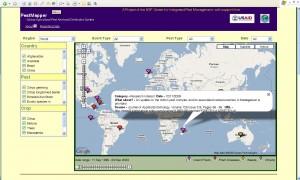Ask how much crop diversity has been lost in the past century or so and one answer is bound to come up. “[A]pproximately 97 percent of the varieties given on the old USDA lists are now extinct. Only 3 percent have survived the last eighty years.” That’s how it appeared in the 1990 book Shattering: Food, Politics, and the loss of genetic diversity, and that’s one of the numbers that has become accepted as a scary measure of genetic erosion.
Pat Roy Mooney and Cary Fowler took a list of vegetable varieties available from US seed catalogues in 1903 and asked how many of them were still held in the USDA National Seed Storage Laboratory in 1983. Their answer: 597 out of 8045, or 3%.
Except that, as is now obvious, 597 out of 8045 is not 3%.
A new paper by Paul Heald and Susannah Chapman at the University of Georgia in the USA says that the figure is wrong, on two counts. First, there’s the little matter of a mathematical error in the original analysis, as presented in Shattering. Rather than 3% — the headline figure — the true survival rate is 7.8%. Or actually, if you count bits of a subsequent analysis by W.W. Tracy, the bloke who compiled the original 1903 list, 7.4%. Tracy noted, as many others have done before and since, that a single variety may go under more than one name. Thus of 578 garden bean varieties listed in the original study, only 185 represented distinct varieties. That difference is essentially trivial.
The other sense in which Heald and Chapman claim that the 3% (or 7.4%, or 7.8% — it really doesn’t matter) figure is wrong is that while 93% of varieties may have disappeared, they have been replaced by other varieties. In their survey of 2004 catalogues, Heald and Chapman count 7100 varieties, “only 2 percent fewer than one hundred years earlier. By this measure, consumers of seeds have seen almost no loss of overall varietal diversity”.
True, as far as it goes. But having berated Fowler and Mooney for not paying sufficient attention to multiple names, it would behoove Heald and Chapman to consider whether, among those 7100 varieties, the amount of genetic diversity is as great as it was in 1903, and whether gardeners are actually getting what they want.
This is certainly not the case in the UK and many other places in Europe, where, for example, there may be many more pea varieties available today, but none of them are the tall-growing varieties with an extended picking season that many gardeners say they would prefer. 1 If I were a betting man, I’d bet that the same is true, though to a lesser extent, in the US.
Heald and Chapman recognize the problem of “how much diversity has been lost” in their summary:
If the meaning of diversity is linked to the survival of ancient varieties, then the lessons of the twentieth century are grim. If it refers instead to the multiplicity of present choices available to breeders, then the story is more hopeful. Perhaps the most accurate measure of diversity would be found in a comparative DNA analysis of equal random samples of old and new varieties, work that remains to be done.
Available to breeders? That’s hardly the point. In any case, I’m not sure the story is more hopeful. I agree that a DNA study would be interesting. Would it, though, change anyone’s perception?
